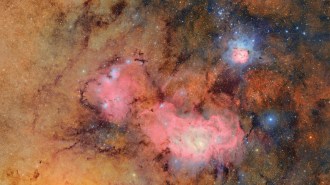DENVER — Astronomers have found more evidence that a class of galaxies that existed in the early universe represent the ancestors of spiral galaxies like the modern-day Milky Way.
Eric Gawiser of Rutgers University in Piscataway, N.J., Lucia Guaita of Rutgers and the Pontificia Universidad Catolica de Chile in Santiago, and their colleagues have discovered 400 galaxies about 10.5 billion light-years from Earth, from a time when the universe was a little more than 3 billion years old. These 400 belong to a class called Lyman-alpha emitters, which cause surrounding hydrogen gas to glow at a particular ultraviolet wavelength.
The clustering of the 400, along with their luminosity, indicates that their individual masses are the equivalent of about 100 billion suns, one-tenth to one-twentieth that of the Milky Way, the team reported May 2 at the American Physical Society meeting. Models of galaxy growth suggest that over the next 10.5 billion years, these galaxies would pack enough mass to become as hefty as the present-day Milky Way.
The masses of the galaxies are similar to those of a group of 162 galaxies, also Lyman-alpha emitters, that Gawiser and colleagues discovered in 2007. Those galaxies originated about a billion years earlier than the newly discovered 400.
Together, the groups suggest that Lyman-alpha emitters are the only type of galaxies in the young cosmos for which the typical member is a precursor to Milky Way–type galaxies, Gawiser says.







